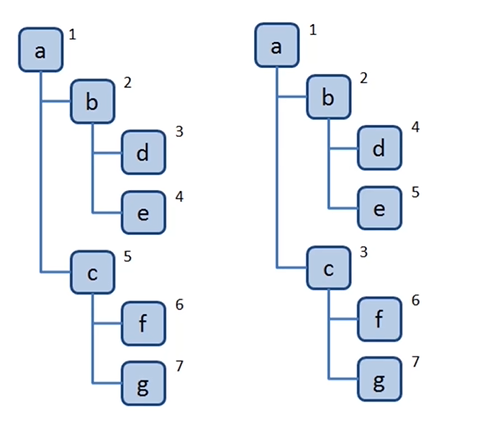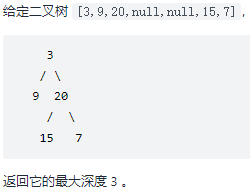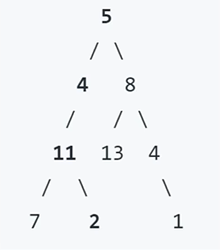"Tree" of data structure
1, Theory
1. Introduction to tree
- Tree is an abstract model of hierarchical data
- Common trees: DOM tree, cascade selection, tree control
- js does not have a tree, but you can use Object and Array to build a tree
- Common operations of tree: depth / breadth first traversal, middle first and then order traversal
2. Depth / breadth first traversal
const tree = {
val: 'a',
children: [{
val: 'b',
children: [{
val: 'd',
children: [],
},{
val: 'e',
children: [],
}],
},{
val: 'c',
children: [{
val: 'f',
children: [],
},{
val: 'g',
children: [],
}],
}],
}

- Depth first traversal: branches of the search tree as deep as possible
- Breadth first traversal: first visit the node closest to the root node
2.1 depth first traversal
- recursion
2.1.1 algorithm formula
- Access root node
- Perform depth first traversal of the children of the root node one by one
2.1.2 coding part
// dfs
const DFS = root => {
console.log(root.val)
root.chileren.forEach(child => DFS(child))
// abdecfg
2.2 breadth first traversal
- queue
2.1.1 algorithm formula
- Create a new queue and queue the root node
- Team leader out of the team and visit
- Join the children at the head of the team one by one
- Repeat 2 and 3 until the queue is empty
2.1.2 coding part
// bfs
const BFS = root => {
const q = [root]
while(q.length) {
const n = q.shift()
console.log(n.val)
n.children.forEach(child => q.push(child))
}
}
// abcdefg
3. Traversal of binary tree from middle to last (recursion)
3.1 what is a binary tree
// bt
const bt = {
val: 1,
left: {
val: 2,
left: {
val: 4,
left: null,
right: null
},
right: {
val: 5,
left: null,
right: null
}
},
right: {
val: 3,
left: {
val: 6,
left: null,
right: null
},
right: {
val: 7,
left: null,
right: null
}
}
}
- Each node in the tree can have at most two child nodes
- js usually uses Object to simulate binary tree
3.2 preorder traversal
3.2.1 formula of preorder traversal algorithm
- Access root node
- First traverse the left subtree of the root node
- The right subtree of the root node is traversed first
3.2.2 coding part
// preorder
const preorder = root => {
if(!root) return
console.log(root.val)
preorder(root.left)
preorder(root.right)
}
3.3 middle order traversal
3.3.1 middle order traversal algorithm formula
- Middle order traversal of the left subtree of the root node
- Access root node
- Middle order traversal of the right subtree of the root node
3.3.2 coding part
// inorder
const inorder = root => {
if(!root) return
inorder(root.left)
console.log(root.val)
inorder(root.right)
}
3.4 post order traversal
3.4.1 postorder traversal algorithm formula
- Middle order traversal of the left subtree of the root node
- Middle order traversal of the right subtree of the root node
- Access root node
3.4.2 coding part
// postorder
const postorder = root => {
if(!root) return
postorder(root.left)
postorder(root.right)
console.log(root.val)
}
4. Traversal of binary tree (non recursive)
- stack
4.1 preorder traversal
coding part
// preorder
const preorder = root => {
if(!root) return
const stack = [root]
while(stack.length) {
const n = stack.pop()
console.log(n.val)
if(n.right) stack.push(n.right)
if(n.left) stack.push(n.left)
}
}
4.2 middle order traversal
coding part
// inorder
const inorder = root => {
if(!root) return
const stack = []
let p = root
while(stack.length || p) {
while(p) {
stack.push(p)
p = p.left
}
const n = stack.pop()
console.log(n.val)
p = n.right
}
}
4.3 post order traversal
coding part
// postorder
const postorder = root => {
if(!root) return
const stack = [root]
const outputStack = []
while(stack.length) {
const n = stack.pop()
outputStack.push(n)
if(n.left) stack.push(n.left)
if(n.right) stack.push(n.right)
}
while(outputStack.length) {
const n = outputStack.pop()
console.log(n.val)
}
}
2, Brush questions
1. Maximum depth of binary tree (104)
1.1 Title Description
- Given a binary tree, find its maximum depth
- The depth of the binary tree is the number of nodes on the longest path from the root node to the farthest leaf node
- Note: leaf nodes refer to nodes without child nodes
1.2 problem solving ideas

- Find the maximum depth and consider depth first traversal
- In the process of depth first traversal, record the level of each node and find the largest level
1.3 problem solving steps
- Maximum depth of new variable record
- Depth first traverses the whole tree and records the hierarchy of each node, constantly refreshing the maximum depth
- Maximum depth returned at the end of traversal
function maxDepth(root) {
let res = 0
const dfs = (n, l) => {
if(!n) return
if(!n.left && !n.right) {
res = Math.max(res, l)
}
dfs(n.left, l+1)
dfs(n.right, l+1)
}
dfs(root, 1)
return res
}
1.4 time complexity & space complexity
- Time complexity: O(n)
- Space complexity: O(logn)~O(n)
2. Minimum depth of binary tree (111)
2.1 Title Description
- Given a binary tree, find its minimum depth
- The minimum depth is the number of nodes on the shortest path from the root node to the nearest leaf node
- Note: leaf nodes refer to nodes without child nodes
2.2 problem solving ideas

- Find the minimum depth and consider breadth first traversal
- In the breadth first traversal process, if a leaf node is encountered, stop the traversal and return to the node level
2.3 problem solving steps
- Breadth first traverses the whole tree and records the hierarchy of each node
- When a leaf node is encountered, return to the node level and stop traversal
function minDepth(root) {
if(!root) return 0
const q = [[root, 1]]
while(q.length) {
const [n, l] = q.shift()
if(!n.left && !n.right) {
return l
}
if(n.left) q.push([n.left, l+1])
if(n.right) q.push([n.right, l+1])
}
}
2.4 time complexity & space complexity
- Time complexity: O(n)
- Space complexity: O(n)
3. Sequence traversal of binary tree (102)
3.1 Title Description
- Give you the root node of the binary tree, root, and return the sequence traversal of its node value
- That is, access all nodes from left to right layer by layer
3.2 problem solving ideas
Input: root = [3,9,20,null,null,15,7]
Output: [[3], [9,20], [15,7]]
- Sequence traversal order is breadth first traversal
- The hierarchy of each node shall be recorded during traversal
3.3 problem solving steps
- breadth-first search
- The hierarchy of each node shall be recorded during traversal
function levelOrder(root) {
if(!root) return []
const q = [[root, 0]]
const res = []
while(q.length) {
const [n, level] = q.shift()
if(!res[level]) {
res.push([n.val])
} else {
res[level].push(n.val)
}
if(n.left) q.push([n.left, level+1])
if(n.right) q.push([n.right, level+1])
}
return res
}
Method 2
function levelOrder(root) {
if(!root) return []
const q = [root]
const res = []
while(q.length) {
let len = q.length
res.push([])
while(len--) {
const n = q.shift()
res[res.length-1].push(n.val)
if(n.left) q.push(n.left)
if(n.right) q.push(n.right)
}
}
return res
}
3.4 time complexity & space complexity
- Time complexity: O(n)
- Space complexity: O(n)
4. Middle order traversal of binary tree (94)
4.1 Title Description
- Given the root node of a binary tree, root, returns its middle order traversal
- Advanced: recursive algorithm is very simple. Can you complete it through iterative algorithm?
4.2 problem solving
function inorderTraversal(root) {
const res = []
const rec = n => {
if(!n) return
rec(n.left)
res.push(n.val)
rec(n.right)
}
rec(root)
return res
}
Method 2
function inorderTraversal(root) {
const res = []
const stack = []
let p = root
while(stack.length || p) {
while(p) {
stack.push(p)
p = p.left
}
const n = stack.pop()
res.push(n.val)
p = n.right
}
return res
}
4.3 time complexity & space complexity
- Time complexity: O(n)
- Space complexity: O(n)
5. Path sum (112)
5.1 Title Description
- Given a binary tree and a target sum
- Judge whether there is a path from the root node to the leaf node in the tree. The sum of all node values on this path is equal to the target sum
- If it exists, return true; Otherwise, false is returned
5.2 problem solving ideas

Input: root = [5,4,8,11, null, 13,4,7,2, null, null, 1], targetsum = 22
Output: true
- During depth first traversal, record the current path node value and
- At the leaf node, judge whether the node value sum of the current path = target sum
5.3 problem solving steps
- Depth first traverses the binary tree. At the leaf node, judge whether the node value sum of the current path = target sum. If yes, return true
- After traversal, if there is no match, false is returned
function hasPathSum(root, sum) {
if(!root) return false
let res = false
const dfs = (n, s) => {
if(!n.left && !n.right && s === sum) {
res = true
}
if(n.left) dfs(n.left, s + n.left.val)
if(n.right) dfs(n.right, s + n.right.val)
}
dfs(root, root.val)
return res
}
Method 2
function levelOrder(root) {
if(!root) return []
const q = [root]
const res = []
while(q.length) {
let len = q.length
res.push([])
while(len--) {
const n = q.shift()
res[res.length-1].push(n.val)
if(n.left) q.push(n.left)
if(n.right) q.push(n.right)
}
}
return res
}
5.4 time complexity & space complexity
- Time complexity: O(n)
- Space complexity: O(logn)~O(n)
6 traverse all node values of json (front end and tree)
const json = {
a: { b: { c: 1 } },
d: [1, 2]
}
6.1 coding part
const dfs = (n, path) => {
console.log(n, path)
Object.keys(n).forEach(k => {
dfs(n[k], path.concat(k))
})
}
3, Summary - technical points
- Tree is an abstract model of hierarchical data, which is widely used in the front end
- Common operations of tree: depth / breadth first traversal, middle first and then order traversal